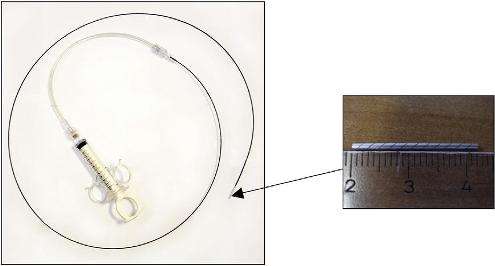Doctors and engineers have designed a new thrombectomy device

CITEF research centre of Universidad Politécnica de Madrid (UPM) has a line of research focused on the usage of simulation techniques of multi-domain systems. CITEF researchers are working on improving a device for the extraction of blood clots through absorption in a way that the device can effectively work without causing an embolism by a clot breaking off. This research is being conducting along with a medical team of the UK. In addition, the laboratory tests for the device modeling are also conducted in this country.
A cerebrovascular accident is the loss of brain function due to disturbance in the blood supply to the brain. In case of a disturbance for more than a few seconds, brain cannot neither receive blood nor oxygen causing permanent damages. According to World Health Organization, over 15,000 people die worldwide due to cerebrovascular diseases. Particularly, cerebrovascular accidents are a leading cause of death and the leading cause of disability in adults. These types of accidents are also neurological diseases of great social impact with over 120,000 new cases a year in Spain.
The treatments for these accidents can be divided into chemical agents and mechanical thrombectomy devices. The goals of any mechanical extraction device are the clot removal and to restore the blood flow of the artery. For years, numerous devices were developed to work in the periphery of the vascular system. However, there are few devices that are being used for cerebral vasculature. One problem of these devices is that can cause downstream embolism or ruptures of artery walls due to their moving parts.
It is necessary the development of new devices that can effectively remove clots because of the high rate of affected population and the associated risks. Researchers are working on a device based on absorption, without mobile parts, with a simple design and that uses an effective extractor of clots without causing embolism due to clots breaks.
The new extracting device is based on the thrombectomy device by absorption known as "GP". This device was invented in UK and does not have mobile parts.
According to the initial design and the agreement with the English medical team, the CITEF researchers are making improvements and optimizing the design through using diverse simulation techniques.
More information: ROMERO, G; HIGUERA, I; MARTÍNEZ, ML; PEARCE, G; PERKINSON, N; ROFFE, C; WONG, J. "Computational Modeling of a New Thrombectomy Device for the Extraction of Blood Clots". Advances in Experimental Medicine and Biology, Vol. 680. 2010. DOI: 10.1007/978-1-4419-5913-3_69
PEARCE, G; BROOKER, L; MIRZA, N; JONES, T; ROFFE, C; WONG, J; PERKINSON, N; ROMERO, G; MARTINEZ, ML; HIGUERA, I. "Bond graph modelling of the in vitro performance of the GP thrombectomy Device in combination with local delivery of alteplase". International Journal of Stroke, Vol. 5(s3). 2010. DOI: 10.1111/j.1747-4949.2010.00492.x
ROMERO, G; MARTÍNEZ, ML; MAROTO, J; FÉLEZ, J. "Blood Clot Simulation Model by Using the Bond-Graph Technique". The Scientific World Journal , Volume 2013. DOI: 10.1155/2013/519047
ROMERO, G; MARTÍNEZ, ML; PEARCE, G; WONG, J. "Analysis of the GPATD: Geometrical Influence on Blood Clot Extraction Using CFD Simulation". UkSim-AMSS 16th International Conference on Modelling and Simulation. 26-28 March 2014. Cambridge (UK).

















